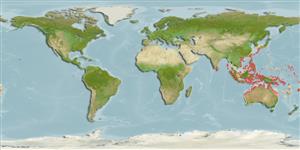Common names from other countries
Classification / Names
Nombres comunes | Sinónimos | Catalog of Fishes(Género, Especie) | ITIS | CoL | WoRMS | Cloffa
>
Gobiiformes (Gobies) >
Gobiidae (Gobies) > Gobionellinae
Etymology: Gnatholepis: Greek, gnathos = jaw + Greek,lepis = scale (Ref. 45335).
More on author: Bleeker.
Environment: milieu / climate zone / depth range / distribution range
Ecología
marino asociado a arrecife; rango de profundidad 0 - 12 m (Ref. 92171). Subtropical
Distribución
Países | Áreas FAO | Ecosistemas | Ocurrencias, apariciones | Point map | Introducciones | Faunafri
Western Pacific: relatively restricted from the Cocos-Keeling Islands, Philippines, Taiwan, southern Japan, Indonesia, New Guinea, Solomon Islands and Vanuatu.
Tamaño / Peso / Age
Maturity: Lm ? range ? - ? cm
Max length : 5.5 cm SL macho / no sexado; (Ref. 92171)
This moderate-sized (up to 55 mm SL) species has a distinctive colour pattern: in males, with 6 broad vertical dark blotchy bars along mid-side of body, several staggered rows of black spots along the dorsal part of the body, 1-4 irregular rows of golden yellow (in life) spots along lower half of body, 2 characteristic small black spots at base of first dorsal fin, and 1-3 staggered rows of oval black ocellate spots on anal fin (in life, red, blue and yellow may surround black spots); in females, with vertical dark body bars much paler and red and yellow markings much less distinct; D2 and anal fin rays nearly always I,11; pectoral rays 15-17 (usually 16); lateral scales 24-30 (usually 26); predorsal scales 9-10 (usually 8-9), ctenoid and cycloid (Ref. 92171).
Found in shallow waters, from reef tidepools, among seagrass, in shallow mangroves and (usually) sand and coral rubble reef substrates at depths of 0.2-12 m (Ref. 92171).
Life cycle and mating behavior
Maturities | Reproducción | Spawnings | Egg(s) | Fecundities | Larva
Larson, H.K. and D.J. Buckle, 2012. A revision of the goby genus Gnatholepis Bleeker (Teleostei, Gobiidae, Gobionellinae), with description of a new species. Zootaxa 3529:1-69. (Ref. 92171)
IUCN Red List Status (Ref. 130435)
CITES (Ref. 128078)
Not Evaluated
Threat to humans
Harmless
Human uses
Herramientas
Special reports
Download XML
Fuentes de Internet
Estimates based on models
Preferred temperature (Ref.
115969): 26.5 - 29.3, mean 28.7 (based on 1531 cells).
Phylogenetic diversity index (Ref.
82804): PD
50 = 0.5010 [Uniqueness, from 0.5 = low to 2.0 = high].
Bayesian length-weight: a=0.00977 (0.00442 - 0.02163), b=3.05 (2.86 - 3.24), in cm Total Length, based on LWR estimates for this (Sub)family-body shape (Ref.
93245).
Nivel trófico (Ref.
69278): 3.3 ±0.4 se; based on size and trophs of closest relatives
Resiliencia (Ref.
120179): Alto, población duplicada en un tiempo mínimo inferior a 15 meses (Preliminary K or Fecundity.).
Fishing Vulnerability (Ref.
59153): Low vulnerability (10 of 100).
